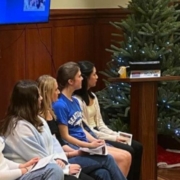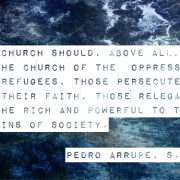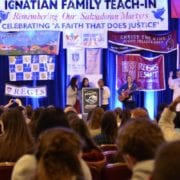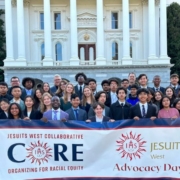A Mysticism of Open Eyes in the Work of Immigration Justice
BY JORGE PALACIOS, JR. | September 9, 2022
My favorite theologian, the 20th-century German theologian Karl Rahner, S.J., once wrote, “The devout Christian of the future will either be a ‘mystic,’ one who has experienced ‘something,’ or [they] will cease to be anything at all.” This experience of mysticism, of having perceived something of the divine within our own experience, might be otherwise described like this: to see things as they actually are, and not how we have been told they are. When we describe mysticism as seeing, it is hard not to invoke Pedro Arrupe, S.J., or even St. Ignatius of Loyola. Ignatius himself describes his visions at the Cardoner river as having, “the eyes of his understanding… opened and though he saw no vision he understood and perceived many things.” Likewise, Arrupe’s personal prayer says, “Grant me, O Lord, to see everything now with new eyes… Give me the clarity of understanding that you gave Ignatius.” Clearly, the symbols of eyes and eyesight are full of meaning in the Ignatian tradition of this understanding, of seeing God at work in creation, which we often invoke with discernment as, “finding God in all things.” The last few weeks since I officially began in my capacity as migration coordinator for youth engagement for the Ignatian Solidarity Network have been an exercise in seeing with open eyes.

A little about me—I grew up on a farm in northern Colorado, I attended Regis Jesuit High School in Aurora, Colorado, and recently finished my undergraduate studies at Regis University in Denver. I grew up in a mixed status household, my father and I being U.S. citizens, and my mother and older brother being undocumented for most of my childhood. Growing up in this situation meant that many things were more difficult: it limited where and how we could travel, it meant my parents could only take certain kinds of work, my brother had a lot of insecurity around how feasible college would be for him, and I lived in the terror of knowing that at any moment my family could be torn apart. So, from a young age, I was keenly aware of what immigration legislation meant to my family and my community. I have watched as immigration reform was championed and stalled across four very different administrations, and I have seen my own family’s immigration status change.
In spite of that, or perhaps because of it, my family’s immigration story has remained an important part of my story, and the rights of immigrants and the undocumented have remained very significant for me. As a college student attending the Ignatian Family Teach-In for Justice for the first time in 2014, and in subsequent years, I gained a lot of perspective around the role of advocacy in the work for immigration justice. As a paraprofessional in a kindergarten class in the Denver Public School system I worked with a lot of immigrant youth, and gained perspective on immigrants from beyond Mexico, where my own family is from. Even in my work in the Environmental Youth Corps world, I saw firsthand how environmental policy affects marginalized groups, including immigrants, disproportionally.
My eyes were opened before, but these last few weeks I have begun to see again with renewed clarity. As I’ve begun to meet and work with folks from around the network, I understand the value of the work we are doing. As DACA continues to be challenged in the federal court system and migrants and asylum seekers are continuously denied entry at the U.S.-Mexico border, it’s been in meeting with folks, sharing their stories, their triumphs, and their anxieties that I am reminded of what it means to be called to a faith that does justice. It really has only been in understanding the reality of those other folks that I have been able to see my own life within the lens of this story of immigration, and more generally, this story of justice. In seeing clearly, in accessing that mystical vision which Rahner points out is the calling for the, “Christian(s) of the future,” of which we now find ourselves a part of, we must be willing to see things as they are.
Seeing things as they actually are involves removing the illusion of normalcy in our immigration system, of acknowledging that the systems which are in place are, in fact, broken. It involves seeing that the millions of immigrants living in this country are our neighbors, contributing to our communities, taking care of our loved ones, growing, transporting, making, and selling the food which nourishes all of our bodies, paying taxes, raising children, participating in our civic and social lives, and calling this land their home, too. Seeing things as they are means hearing the stories of people seeking asylum, of those who have left homes, family, and communities behind in order to find safety, and the ways in which they are still seeking safety. It involves knowing that young people who came to this country as children don’t know another home but this one, and yet they are still living in fear of being forced to leave. Seeing things as they actually are involves recognizing the ways in which racism, xenophobia, and white supremacy culture diminish the dignity of our neighbors in our midst, and often pits us against people who have more in common with us than we might realize.
To begin to live within this mystical vision, we must also dare to have the prophetic hope to see things as they might be. At the Ignatian Justice Summit I met many college students energized and excited about working for ecological and immigration justice. In their midst I saw the possibility of how we may begin to activate our communities to work for a more just world for all of us. These young leaders reminded me of the hope I’ve had for our present and our future. In meeting partners from around the network I’ve seen glimpses into the work of solidarity and justice. Even as I write this post, I realize how the contemplation so central to the spirituality of St. Ignatius has allowed me the capacity to see now with my own eyes what I was not allowed to see in the moment of encounter: that within the presence of the other is the possibility for a better future we can build together, lifting up the voices of those often not heard, and giving full view of those who0 are often overlooked.
I am energized by the young people I have met, emboldened by the strength of those who have shared their stories, and sustained by the wisdom of those who have come before me. I am excited by the possibility of what we have before us. It is in seeing with this mystical vision, seeing things as they are, that we can unlock the potential of how things may be. If we can manage to share this vision with others, maybe we can all live together under the roof of harmony, in this house which we have built—a home where everyone belongs and no one is excluded.
If we can begin to see the reality of immigration in this country, we may bring this dream to fruition: to see the broken systems replaced and repaired, giving the promise of safety, security, and the opportunity to contribute to society without the fear of harm or retribution. In the mystical vision of how our system exists now, and those who are victimized by it, there lies the potential for a path to citizenship for all of our most marginalized neighbors. I am excited for what opportunities may continue to arise in my work for ISN to work to fit Rahner’s definition of a Christian, and to pray for vision. I look forward to the many conversations and partnerships that will allow us to access this new dream here on Earth.
Jorge Palacios Jr. has served as the Migration Coordinator for Youth Engagement for the Ignatian Solidarity Network since 2022. He grew up on a cattle farm in northern Colorado and attended Regis Jesuit High School, and then later Regis University in Denver, Colorado. He has worked as a crew leader on chainsaw crews local youth corps, as a kindergarten paraprofessional, and most recently served as liturgist and music director at Annunciation Catholic Church in Denver. Jorge currently lives in Golden, Colorado.










Thank you Jorge Palacios Jr. for this detailed reflection. Let me wish you all the very best in your challenging mission.